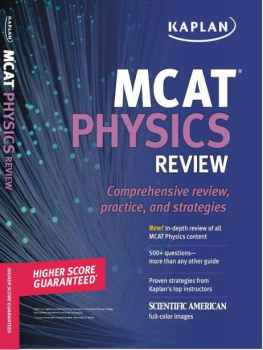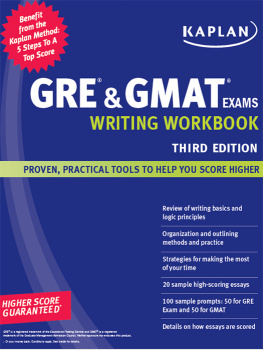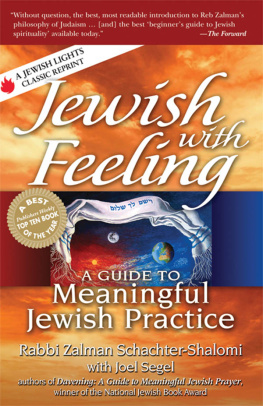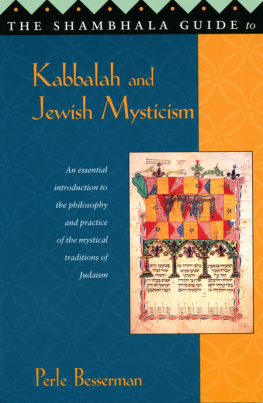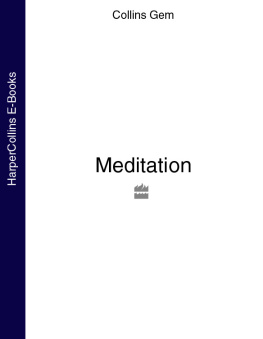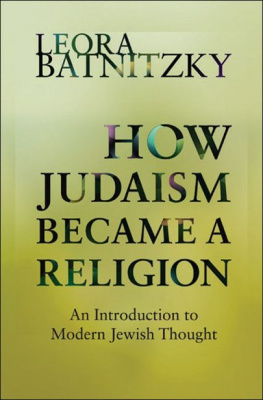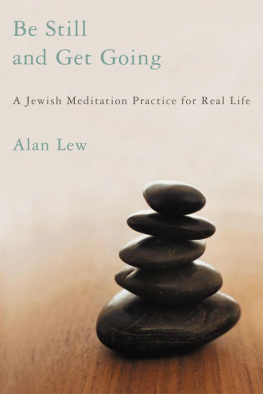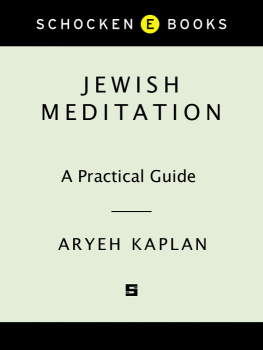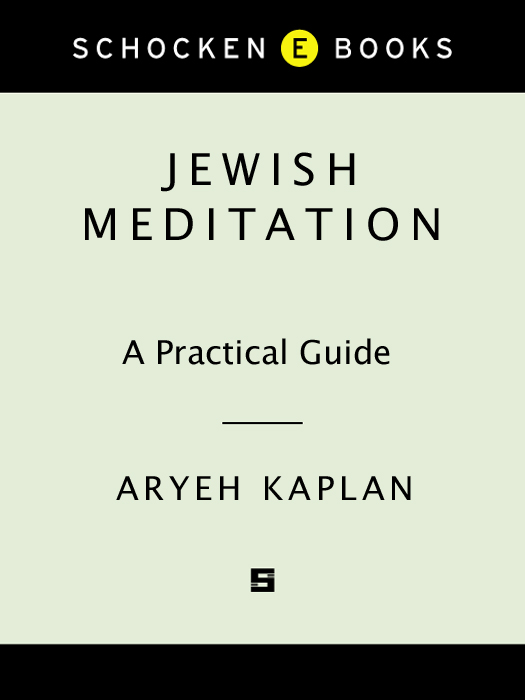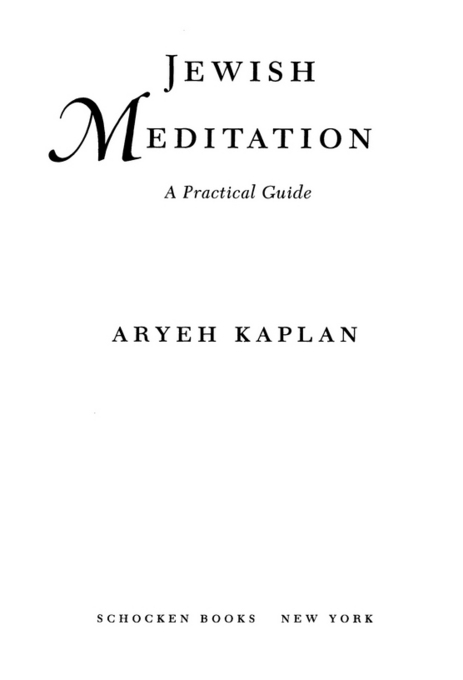COPYRIGHT 1985 BY SCHOCKEN BOOKS INC.
All rights reserved under International and Pan-American
Copyright Conventions. Published in the United States by Schocken
Books Inc., New York. Distributed by Pantheon Books,
a division of Random House, Inc., New York.
Originally published by Schocken Books in 1985.
Library of Congress Cataloging in Publication Data
Kaplan, Aryeh
Jewish meditation: a practical guide
1. Meditation(Judaism)
1. Title
BM723.K288 1985 29672 84-23589
eISBN: 978-0-307-76111-8
The publisher acknowledges with gratitude the assistance of Mrs. Anita Lasry in the preparation of this book.
v3.1
CONTENTS
INTRODUCTION
P eople are often surprised to hear the term Jewish meditation. Otherwise knowledgeable Jews, including many rabbis and scholars, are not aware that such a thing exists. When shown texts that describe Jewish meditation, they respond that it belongs to esoteric or occult corners of Judaism and has little to do with mainstream Judaism.
It is therefore not surprising that many current books on meditation give scant attention to Judaism. Although most writers seem to be aware that mystical elements exist in Judaism, their discussion is usually restricted to the Kabbalah or the Chasidic masters. Most books on meditation emphasize Eastern practices, and in some instances Christian meditation, but Jewish meditation is for all practical purposes ignored.
For students of meditation, this is a serious oversight. Judaism produced one of the more important systems of meditation, and ignoring it is bound to make any study incomplete. Furthermore, since Judaism is an Eastern religion that migrated to the West, its meditative practices may well be those most relevant to Western man. Without a knowledge of Jewish meditative practices, an important link between East and West is lost. This omission is all the more significant in light of considerable evidence that the Jewish mystical masters had dialogue with the Sufi masters and were also aware of the schools of India.
For the Jew, however, the lacuna is most serious. Jews are by nature a spiritual people, and many Jews actively seek spiritual meaning in life, often on a mystical level. Generations ago, large numbers of Jews were attracted to the mystical traditions of groups such as the Freemasons. Today, many American Jews have become involved in Eastern religions. It is estimated that as many as 75 percent of the devotees in some ashrams are Jewish, and large percentages follow disciplines such as Transcendental Meditation.
When I speak to these Jews and ask them why they are exploring other religions instead of their own, they answer that they know of nothing deep or spiritually satisfying in Judaism. When I tell them there is a strong tradition of meditation and mysticism, not only in Judaism, but in mainstream Judaism, they look at me askance. Until Jews become aware of the spiritual richness of their own tradition, it is understandable that they will search in other pastures.
A few years ago, I was invited to speak in a small synagogue in upstate New York. The weather was bad that evening, and only twenty people showed up, so instead of giving the lecture I had planned, I gathered everyone into a circle and just talked. Most of the people there had relatively little knowledge of Judaism. In the course of our talk, I began to discuss the Shema and how it can be used as a meditation (see ). One of the women present asked if I would do a demonstration, and I agreed.
The whole meditation could not have taken more than ten or fifteen minutes. Ordinarily, it would have taken longer, but in this situation I felt pressed for time. Still, at the end, everyone present, including me, was literally breathless. Collectively, we had experienced a significant spiritual high.
Why cant we ever do anything like this at services? asked one of the men. It was a question I could not answer. The discussion turned to how cold and spiritually sterile synagogue services can be, and how a technique like this, which works so well in a group, could make the service infinitely more meaningful. Together we questioned whether the synagogue service was initially meant to be a meditative experience.
If finding spiritual meaning is difficult for the uncommitted Jew, it is sometimes difficult for the Orthodox Jew as well. I have been approached by yeshiva students who are committed to observing the rituals of Judaism but fail to see how these practices can elevate them spiritually. Even more troubling is the number of Orthodox Jews who are involved in disciplines such as Transcendental Meditation. Most of them express uneasiness about these practices but feel that the benefits outweigh the dangers. When asked why they do not seek this type of experience in Judaism, they give the same answer as uncommitted Jews: they are not aware that such an experience can be found within Judaism.
When my first book on the subject, Meditation and the Bible, was published in 1978, it sparked a new interest in Jewish meditation in many circles. For most people, it was the first intimation that Jewish meditation existed. Although the work drew on a considerable amount of published material, most of the sources had never been translated from the Hebrew and were available only to experienced Hebraic scholars. Even then, much of the material was difficult to understand for someone who had not engaged in meditative practices. To make this material accessible, the keys to understanding had to be found, and many of these keys existed only in ancient, unpublished manuscripts.
It is significant that most of the important texts on Jewish meditation have never been published, even in their original Hebrew. The most important works exist only in manuscript, locked away in libraries and museums. To research this book, as well as a subsequent work, Meditation and Kabbalah, the manuscripts first had to be located; this involved searching through scholarly journals and library catalogues. Once the manuscripts were found, copies had to be obtained, and when they were located in places like the Lenin Library in Moscow, this was not an easy task. Many of the manuscripts were hundreds of years old, written in obsolete scripts that could be deciphered only with considerable effort. The effort was worth it, however, and many important keys to Jewish meditation were discovered.
Because so little on Jewish meditation was ever published, many people argued that meditation was to be found only in the backwaters of Judaic literaturein works not even worthy of publication. Actually, many works dealing with Kabbalistic methods of meditation were not published because the practices were dangerous and were not meant for the masses. Still, even these works shed considerable light on obscure passages found in published mainstream works; they are an integral part of the puzzle, without which major areas of Judaism are difficult, if not impossible, to understand. Once the puzzle began to come together, it became clear to me that some of the most important mainstream Jewish leaders of the past relied on various meditative techniques.
With the publication of Meditation and the Bible, interest in Jewish meditation began to grow. Even the Lubavitcher Rebbe issued a directive that Jewish forms of meditation should be explored. Groups that taught and practiced Jewish meditation were formed in the United States and Israel. I felt privileged that my books formed the basis of many of these groups.




